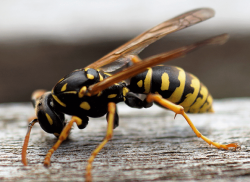Yellow Jackets
| Color | Abdomen usually black and yellow pattered similar to bands |
| Legs | 6 |
| Shape | Wasp-like |
| Size | 3/8″ to 5/8″ |
| Antennae | True |

Yellow jackets are a type of wasp belonging to the Vespidae family. They are known for their yellow and black striped markings, which resemble those of bees. Yellow jackets are social insects that live in colonies, typically consisting of queens, workers, and males.
These wasps are found in various parts of the world, including North America, Europe, and Asia. They are adaptable insects and can thrive in diverse environments. Yellow jackets are often encountered near human habitation, as they are attracted to food and sweet substances.
Yellow jackets are carnivorous and feed primarily on insects, spiders, and other arthropods. They are also drawn to sugary foods and are commonly seen scavenging around garbage bins, picnics, and outdoor gatherings.
One notable characteristic of yellow jackets is their aggressive nature when their nests or food sources are disturbed. They can sting multiple times, and their stings are known to be painful. Unlike honey bees, yellow jackets do not lose their stingers after stinging, allowing them to sting repeatedly.
Yellow jackets build nests, which can vary in location depending on the species. Many yellow jackets, such as the common yellow jacket (Vespula vulgaris) and the German yellow jacket (Vespula germanica), construct their nests in the ground. The queen selects a suitable location, often in a pre-existing cavity or hole, and the workers build multiple layers of cells from chewed wood fibers to house the developing larvae.
While yellow jackets are often considered pests due to their aggressive behavior and painful stings, they do provide ecological benefits. They help control populations of other insects, including agricultural pests and flies, making them valuable predators in ecosystems.
When dealing with yellow jackets, it is important to exercise caution and avoid provoking them. If you have a yellow jacket nest on your property or frequently encounter them in problematic areas, it is recommended to consult professional pest control services for safe and effective removal.
Are Yellow Jackets Bees or Wasps?
Yellow jackets, with their distinctive yellow and black markings, are often a cause for concern due to their aggressive nature and painful stings. However, there is often confusion surrounding their classification. Are yellow jackets bees or wasps? Let’s delve into the fascinating world of these insects to find out.
Yellow jackets are actually a type of wasp. They belong to the Vespidae family, which includes various species of social wasps. While they share some similarities with bees, such as their buzzing flight and the ability to sting, there are distinct differences between the two.
Where Do Yellow Jackets Live?
Yellow jackets are found in many parts of the world, including North America, Europe, and Asia. They are particularly common in temperate regions. These insects are known for their adaptability and can thrive in diverse environments. They are often found near human habitation, as they are attracted to food and sweet substances.
Do Yellow Jackets Build Nests in the Ground?
Yes, yellow jackets commonly build their nests in the ground. They are known as ground-nesting wasps. The queen selects a suitable location, often in a hollow or burrowed area, such as an abandoned rodent hole or a dense patch of vegetation. The workers then construct their nest by chewing wood fibers to create a papery material. They build multiple layers of cells to house the developing larvae.
Why Do Yellow Jackets Sting?
Yellow jackets have a reputation for being aggressive and readily stinging when threatened. However, it’s important to understand that their stinging behavior is primarily defensive. They sting in response to perceived threats to their nest or themselves. When a yellow jacket stings, it releases a chemical pheromone that alerts nearby colony members, leading to a potential swarm.
Why Do Yellow Jackets Swarm?
Yellow jackets are social insects that live in colonies, which can consist of hundreds or even thousands of individuals. When the nest is disturbed or under threat, the yellow jackets may respond by swarming. Swarming is a defensive behavior where a large number of workers emerge from the nest to protect it. Swarming can be a formidable sight and poses a higher risk of multiple stings
How to Get Rid of Yellow Jackets?
Dealing with a yellow jacket infestation can be challenging, especially due to their aggressive nature. Here are some methods for removing yellow jackets:
- Locate the Nest: Identify the nest’s location during the day when the yellow jackets are most active. Exercise caution and approach the nest from a safe distance.
- Professional Pest Control: For large or inaccessible nests, it’s advisable to seek assistance from professional pest control services. They have the experience and knowledge to handle the situation safely.
- Traps: Yellow jacket traps can be effective in reducing their population. These traps contain attractants that lure the wasps into a container, where they become trapped.
Prevention is key when it comes to avoiding yellow jacket infestations. Here are some preventive measures:
- Cover Food and Garbage: Yellow jackets are attracted to food sources, so it’s important to keep outdoor food and trash covered tightly. Clean up spills promptly.
- Seal Entry Points: Seal any cracks or openings in your home’s exterior to prevent yellow jackets from entering.
- Remove Nesting Sites: Regularly inspect your property for potential nesting sites, such as old rodent burrows, and take measures to eliminate them.
- Avoid Strong Scents: Perfumes, sweet-scented lotions, and floral patterns can attract yellow jackets. Be mindful of these scents when spending time outdoors.